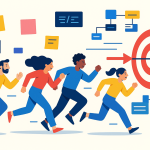Let’s dive into the evolution of Agile and make some informed predictions about its future.
Agile’s Trajectory Since 2001
- The Early Days: Back in 2001, the Agile Manifesto revolutionized software development. The focus was on flexibility, customer satisfaction, and iterative improvements over rigid, drawn-out processes.
- Mainstream Adoption: Agile steadily seeped out from software development into other domains. Teams in marketing, operations, and even HR began recognizing the benefits of working in smaller increments with regular feedback loops.
- Scaling Challenges: As Agile took over larger and more complex projects, cracks started to appear. The need for frameworks to scale Agile (SAFe, LeSS, etc.) became evident.
- Hybrid Approaches: The realization grew that sometimes a blend of traditional project management methods and Agile was necessary, especially in large-scale enterprise endeavors.
- The AI Infusion: Artificial intelligence and machine learning started to infiltrate Agile processes, aiding in everything from task automation to intelligent recommendations and data-driven decision-making.
Crystal Ball Predictions: The Future of Agile
- Agile as the Norm: No longer considered a niche approach, Agile principles will become the default way projects are managed across most industries. Expect terms like “iteration” and “sprint” to be common vocabulary even outside tech circles.
- Emphasis on Value Delivery: The focus will shift even further towards demonstrable value for the customer. Agile won’t just be about building things quickly, but ensuring what is built is genuinely solving problems and providing a compelling user experience.
- Enhanced Scalability: Frameworks for scaling Agile will mature and be refined. This will empower organizations to smoothly implement Agile on large, complex projects with multiple teams and dependencies without losing the core benefits of flexibility and responsiveness.
- AI-Powered Agile: AI will become deeply interwoven into Agile workflows. Expect intelligent tools that can predict roadblocks, suggest optimizations, automate testing, and provide data-driven insights to streamline the entire process.
- Focus on Soft Skills: While technical prowess remains important, the emphasis on collaboration, communication, and adaptability –the heart of the Agile philosophy– will intensify. Agile teams of the future will prioritize these qualities to ensure seamless teamwork.
- Agility Beyond Projects: Agile thinking will extend far outside of project-based work. Concepts like rapid experimentation and continuous learning will influence business functions as diverse as human resources, strategy development, and even customer service.
Caveats
- “Agile” May Fade as a Buzzword It’s possible that the basic tenets of Agile become so ingrained the specific term fades in use, much like we don’t often call things “customer-focused” anymore – it’s just expected.
- Unexpected Disruptors: It’s always wise to leave room for unforeseen technologies or methodologies completely changing how we collaborate and deliver work. The future holds surprises!
In Summary
Agile has fundamentally changed how we approach work. Its journey is far from over. The future will likely see Agile become more deeply embedded, more intelligent, and even more focused on delivering tangible value. Hold on tight, because Agile’s evolution is sure to be an exciting ride!





